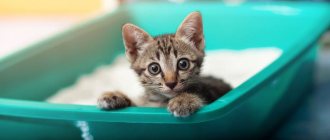5930Administration
A newborn kitten is always a joy for all inhabitants of an apartment or house. You need to prepare for it in advance. Despite the fact that a cat knows at the genetic level how to survive in nature, it is not always able to survive this process on its own. Therefore, every cat owner should know what to do if the cat cannot give birth.
There are cases when, if help was not provided, a pet began to die from various complications. This usually affects artificially bred breeds that have undergone changes at the genetic level and cannot reproduce normally. Therefore, they are not able to cope with what ordinary yard animals can easily cope with.
© shutterstock
How does childbirth occur in cats?
Cats bear offspring for approximately 2.5 months. During one birth, 1-2 kittens are born, as well as 6-7. The process itself takes several hours and consists of several stages. If you are helping your cat give birth, then you need to know how everything usually goes:
- pushing – kittens pass through the birth canal in 4-5 pushing;
- birth - kittens come out in the amniotic sac, less often without it;
- starting breathing - the cat breaks the bubble and licks the born kitten, removing mucus from the respiratory tract;
- rupture of the umbilical cord, eating the placenta - after the kittens, an afterbirth (placenta) comes out, which the cat eats. As many babies are born, so many placens should come out.
Human assistance may be required at each stage of the birth of kittens. When all the babies have come out, all the amniotic sacs have been ruptured, the cat has licked all the babies and they are suckling milk - everything is done. Further assistance will be reduced to proper care of the newborn pet.
To know for sure that all the kittens have come out, it is advisable to first do an ultrasound and count the fetuses. Then there will be no cause for concern if the number of babies born coincides with the number given by the veterinarian.
At what age can a cat give birth?
Those owners who have not previously encountered cats should remember that sterilization should not be shelved, since these animals can begin to bear offspring very early. The average cat goes through puberty by the age of eight months. If a cat owner plans to have kittens, then it is better to bring the animal with a partner after a year. The best option would be the fourth heat.
A cat's pregnancy lasts about two and a half months.
It is very easy for a person who has a cat at home to understand when she begins to go into estrus, that is, into heat. Based on the behavior of the animal, it immediately becomes clear that the cat has matured.
The entire period of estrus in cats can be divided into three stages. The first lasts about three days. At this time, the animal will constantly rub against its legs and require a lot of attention. Then there will be several days of rolling on the floor meowing loudly. At this time, the cat often walks with its tail moved to the side. Then comes the third stage, when the discharge is still there, that is, the cat attracts males, but at the same time it becomes aggressive towards them. If fertilization does not occur, this period can last up to 20 days. In a fertilized cat, it is reduced to one week.
A cat's pregnancy lasts about two and a half months. At one time, an animal can give birth to an average of four to seven kittens, but a lot depends on the breed of the cat. A person should carefully monitor when a pet goes into labor. If they are premature, which is not uncommon for the first time, then the babies are unlikely to survive. It’s also bad when a cat can’t give birth for a long time.
For the expectant mother you need to prepare a bed
Correct care for a woman in labor
In the wild, cats give birth on their own, but in domestic cats, their natural instincts are muted. For this reason, it is desirable that the owner be nearby during childbirth and can provide the necessary assistance in a timely manner. It is especially needed for a cat giving birth for the first time. The pet can only guess what will be required of her. The owner’s task is to act competently and, if necessary, call a veterinarian.
Correct actions with the amniotic sac
If the bubble with the kitten inside is not damaged, if the fetus lies correctly head first, then your help will not be required. You need to intervene in the following cases: - if the bubble is torn, prepare a clean cloth, wrap it around the kitten and gently pull at the next contraction; - if the bladder is torn and the kitten is walking butt, pull without waiting for a contraction, speed is more important so that the baby does not suffocate.
If the cat does not chew the amniotic sac, this must be done for her. You will need sterile scissors. Act quickly - if you wait more than half a minute, the kitten may suffocate.
If the kittens are too big
It is difficult for a cat to give birth to large babies. It will also be difficult for you to remove the kitten; it will slip back into the vagina. If your cat's vulva is dry, lubricate it with Vaseline or lubricant. Proceed as follows: - wait for the next contraction when the baby approaches the vulva; - insert the index finger of a sterile-gloved hand into the vulva a few centimeters and move the skin towards the anus; - as soon as the kitten appears, grab it and move it slightly to help it come out. Determine the intensity of the impact yourself individually.
What to do if a kitten gets stuck
A few hours before birth, kittens take a forward-facing position. But sometimes babies change position or their head is turned to the side, making it difficult to exit the vulva. To help a stuck kitten be born, lubricate the vulva with lubricant or Vaseline and with a sterile gloved hand perform the following manipulations: - carefully insert your finger into the baby’s mouth, if the amniotic sac allows it; — turn the kitten’s head in the right direction so that the cat’s contractions push it further; - press on the cat's perineum at the bottom of the anus - this will cause a contraction, and the baby will not be able to return back.
We do the same if the kitten moves forward with its sacrum - grab it by the paws and guide it along the birth canal.
It happens that for some reason kittens die in the womb. In this case, they will still be born naturally. The cat will go into labor, and if your help is needed, you can act less carefully. It is important that everything is in order with the cat, so if the fetus is stuck, feel free to pull on any part of the body.
Causes
Mechanical interlock
The “diving position”—exiting the birth canal with your nose and feet first, and your back near the top of the vagina—usually produces kittens. A kitten that is too large or a kitten that is not positioned correctly in the birth canal are two main causes of mechanical blockage.
- The kitten emerges from the birth canal backwards, showing its hind legs or tail and hips.
- A reversed position of the tail or rump is called a pelvic position, and if it occurs with the first kitten, it can indeed be a problem.
- Twisted head, in which the kitten's head is curved forward or to the side.
Inertia of the uterus
When the muscles of the uterus become too weak, labor becomes futile. The uterus cannot produce strong and effective contractions. Causes of uterine fatigue include:
- Very large litter
- One very large kitten in a tiny womb
- Distortion of the uterus
- Excess amniotic fluid resulting from a condition called hydrocele.
What not to do during childbirth
In the desire to help a giving birth cat, it is important not to harm. There are a number of actions that are prohibited. What you shouldn't do:
- do not press on the stomach, this will cause pain to the cat and harm the kittens inside;
- do not pull the umbilical cord so that it does not break or cause a hernia in the cat;
- do not burst the bladder if the woman in labor is ready to do it herself;
- Do not give injections without your veterinarian's approval and do not use medications to induce normal labor.
- do not use instruments without sterilization to avoid infection;
- Do not take kittens away from your cat immediately after birth.
Diagnostics
Failure of a cat to give birth is usually caused by several factors, including uterine inertia, the birth canal is too small, the fetus crosses the birth canal in an atypical orientation, and/or the fetus is too large.
Veterinarians pay attention to the following situations and medical history:
- History of dystocia or obstruction of the reproductive tract.
- Labor does not occur for at least 24 hours after the rectal temperature drops to 37.7 degrees Celsius.
- A kitten is not born after the cat suffers severe abdominal contractions that last more than two hours.
- The pause in labor lasts more than four to six hours.
- The cat's obvious pain is howling, licking.
- Strange discharge from the vulva before the kittens are born (the placenta may have separated).
- Pelvic injury.
- Previous births.
The veterinarian may also perform a sterile digital examination to determine the degree of obstruction of the birth canal and the position and presentation of the fetus. The veterinarian may also use x-rays or ultrasound scans to determine the presence, weight, location and health of fetuses.
If labor is prolonged and veterinarians cannot see or feel the kitten in the birth canal, x-rays of the cat will help determine the relative size and position of the kittens.
© shutterstock
A pelvic fracture is devastating for cats. If a cat with a pelvic fracture becomes pregnant and was not known to have a pelvic fracture, she will have to undergo surgery to give birth.
Veterinarians warn that cats with pelvic fractures should not become pregnant. X-rays taken before pregnancy can determine whether a cat is suffering from this condition.
Necessary preparation
Despite the fact that giving birth to a cat is a natural process, the owner of the animal will face considerable troubles. A cat living at home needs to create a special environment for the birth of offspring, provide veterinary care if necessary, “meet” new residents and make sure that they and the mustachioed mother have enough nutrition.
Arrangement of the “room” for childbirth
Arrangement of the place
If you do not prepare a place for the cat to give birth in time, she will find it herself. This is not always convenient, since a cat is a secretive animal, and it will hide with special care. Some cats leave home altogether and return, bringing kittens one at a time.
The ideal cat place would be a box or large basket with high walls. This could be a house from a pet store, a cardboard box, or even a cabinet drawer. It is important that it is sufficiently closed and spacious, but at the same time not too large - the expectant mother should feel safe and calmly feed the kittens.
Place the “maternity ward” away from drafts, bright light and doors: the place should be secluded and darkened. Place an old small mattress at the bottom of the box or drawer, then lay down an oilcloth, and place a regular baby diaper on top.
A quiet, cozy place where the cat will not be disturbed
Important! It is worth showing the cat the place in advance. If she still stubbornly seeks shelter, ignoring the prepared place, you should take her to the box when the birth process has already begun.
What materials, tools and medications may be needed
You need to thoroughly prepare for childbirth. To do this, you will need not only to arrange the place where the kittens will appear, but also to prepare some tools and materials that may be needed in case of complications that arise. In addition, you should make sure you have medications on hand.
For home birth you will need the following:
- telephone number of a veterinarian who can be contacted at any time;
- clean strips of fabric - you can tear a cotton sheet;
- disposable diapers; sterile threads (pre-soaked in alcohol); sterile scissors with blunt ends (can be boiled for 10-20 minutes);
- gloves;
- alcohol antiseptic or alcohol for hand treatment;
- container for placenta;
- warmer;
- baby bulb or pipette for suctioning mucus.
- healing ointments, for example, Levomikol, Vaseline, oxytocin, potassium gluconate.
You should prepare as much as possible for childbirth, so as not to be terrified of searching around the house for everything you need.
Prepare everything you need in advance for cat and kitten hygiene











